.
.
.
A couple of things happened along the process of destabilizing the USA's 'policeman of the Gulf' and the most high profile loyal ally of the country in the developing world, who pumped billions of petro-$ into the USA economy annually through trade, deposited 10's of billions of petro-$ into USA banks never to be returned to Iran and its people, and who had free access to buy any weapon system from the USA.
1. The Carter administration initiated it from 1977.
2. The Carter administration told the Shah to loosen his SECURITY in the country, and introduce more 'democratic' initiatives designed by the USA via civil society and NGO's.
3. The USA pressed for release of political prisoners who were opposed to the Shah, mainly left-wing, who then upon release agitated and mobilized the country against the Shah with help from the CIA.
4. The CIA conducted destabilization inside the country, especially from 1978 onward. It ARTIFICIALLY gave the impression that people were unhappy with the Shah, at a time and in a space of a few years when in fact the Iranian economy was being heralded as the new Asian economic miracle. Iranians, at least economically never had it so good under the Shah.
5. The Shah was put in a position of limbo, where his key initiatives to stay in power had no effect.......and he became HIGHLY erratic with the reigns of power veering at one time from being overly aggressive to another time being highly sympathetic to the 'dissidents' voice to the extent that he imprisoned his own ministers as sacrificial lambs to the rent a mobs. (rent a mobs being a key feature of the 1953 coup to remove the democratically elected Mosaddegh government, also)
6. 800 senior CIA officers were removed from the organization as a result of the Church investigations. Many of these officers were sympathetic to the Shah, and had provided the security support to maintain him in power since 1953.
7. In 1978, 3 million barrels or 50% of Iranian oil production...68% of all oil exports were suddenly cut off. The Shah suddenly found he had liquidity problems, and the ability to pay the wages and salary of state workers including security personnel.
8. AS THE REPORT STATES BELOW.....the USA government told the Shah not to use the army against the rent a mobs. The Persian military could have kept the Shah in power, but instead, being an obedient puppet the Shah followed the advice of the USA embassy, and emissaries from Washington.......he was a puppet after all of the USA, and that is what puppets do, OBEY THEIR MASTER.
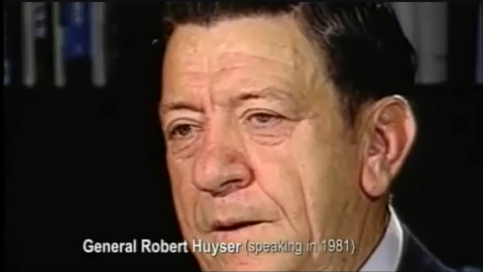
WHY?:
Many theories as to why the Shah was removed by the USA.
During the 1970's extremist Jews in Israel and in the West felt that Israel could get greater mileage if Islamic fundamentalism was promoted by them using the intelligence services of several countries. The CIA taking the lead role.
(i) Islamic fundamentalism could be used to destabilize the Southern part of the Soviet Union which was predominantly Muslim populated (Soviet Central Asia), through a policy known as the 'Arch of Crisis' coined by Bernard Lewis in 1975, and a 'Clash of Civilisation'
(ii) Islamic fundamentalism could also be used as a bulwark against Communism and draw the Soviet Union into a Bear Trap in Afghanistan through the 'Arc of Crisis' policy.
(iii) Islamic Fundamentalism would also draw the efforts of the USA/NATO fighting directly their manufactured crisis..'Crisis management'...create the problem provide the solution. This action would appear thus to conflate Israeli and 'Western' geo-strategic interests. 'We are in this fight together for the sake of civilization.'
(iv) Islamic Fundamentalism with its permanent radical revolutionary agenda has a tendency to destroy otherwise developing states. Iran is destroyed, as is Afghanistan, Iraq, Syria, Libya, Tunisia, Egypt, Yemen, Somalia.
(v) Manufactured Islamic Fundamentalism allows Israel a leadership role in security at least through its influence over the USA, and a measure of influence the country would not normally enjoy given its tiny size. GWOT. It allows Israel a much more assertive foreign policy, and introduces flexibility to a degree unheard of due to its size and borders. It also allows it to entertain the idea of 'Eretz' Israel or Greater Israel from the ashes of a Balkanised Middle East.
From aangirfan:
In 1976, Likud's Binyamin Netanyahu founded the Jonathan Institute.
Those involved included Michael Ledeen, Bernard Lewis [2], George W. Bush, Menahem Begin, Lord Chalfont and Jeane Kirkpatrick.
Ledeen "was one of the brains behind the CIA's Operation Gladio Terrorism in Europe."
Netanyahu and his institute helped to create the 'War on Terror'.
Apparently Netanyahu wanted:
1. To continue to promote the Jihadis and the Wahhabi/Salafi sect.
Israel then initiated the creation of Hamas in Palestine to replace the PLO.
The pro-USA Shah was destabilized, threatened and replaced by the mullahs in 1979.
The USA/UK started funding the Islamist Afghan Mujaheddin against the Communist government in Kabul from 1979.
In 1981 the USA backed a coup by the Muslim Brotherhood to kill the President of Egypt, Anwar Sadat along with a coup in 1981.
In 1982, the USA backed a covert coup by the Muslim Brotherhood to overthrow the Socialist regime of Hafiz al-Assad.
In 1994 The USA creates the Taliban in Afghanistan.
In 1995 The USA introduces 'al-CIA-duh' fighters from Afghanistan/Pakistan into Europe...Bosnia, with finance from Iran.
1995..1996...the concept of 'al-CIA-duh' as a global terrorist organisation that actually exists is introduced to the world through the USA global propaganda machine.
1996---2001 'al-CIA-duh' carries out various terrorist attacks around the world just to let everybody know that such a fake entity really exists and is a menace to the world. 'al-CIA-duh' is attacked by high profile USA attacks just to let the world know that 'al-CIA-duh' is a global threat which the USA is fighting for the safety of the world.
2001....9/11 carried out by American security and Israel.
2001 Afghanistan is occupied
2003 Iraq is invaded
2003--2011....Iran receives daily threats of invasion and airstrikes by the USA/Israel. Pakistan is droned, and bombed with the aid of the Pakistan army. Indonesia is bombed by 'al-CIA-duh' affiliates with the aid of KAPASSUS and the Indonesian security. Suddenly for no reason there is a Muslim rebellion in the South of Thailand managed by the Thai army. There is a Muslim rebellion by 'al-CIA-duh' affiliates in the Philippines managed by the USA........AND SO ON.
2011...The USA this time with NATO partners overthrows the Socialist government of Qaddafi with the aid of traitors in the Libyan Peoples Army (LPA) and 'al-CIA-duh'.
2011 .....The USA this time with NATO partners overthrows the Socialist government of Mohammed Mubarak with the aid of traitors in the Egyptian Army and 'al-CIA-duh' affiliates the Muslim Brotherhood. The USA backed traitors in the Egyptian army tell Musbarak that they could no longer protect him from the Islamic funded, USA backed 'Gucci elite youth' rent- a -mobs in the Presidential Palace. Shades of the Shah of Iran in 1978/9, except that the Imperial Iranian military remained loyal to the last, BUT the USA insisted that there was no hope and the Shah should leave the country for his own safety.
2011..The USA this time with NATO partners attempts to overthrows the Socialist government of Assad with the aid of traitors in the Syrian Peoples Army (LPA) and 'al-CIA-duh' affiliates.
2014...The USA introduces ISIS through NATO Turkey into Syria and Iraq.
2015...ISIS contingents are sent to Afghanistan to spread their terrorism for the USA.
So after 37 years of this great tragedy we now finally have the truth....sort of.
___________________________________________________
US had extensive contact with Ayatollah Khomeini before Iran revolution
Documents seen by BBC suggest Carter administration paved way for
Khomeini to return to Iran by holding the army back from launching a
military coup
.
.
.Iranian leaders have reacted with fury to reports that newly
declassified US diplomatic cables revealed extensive contacts between
Ayatollah Khomeini and the Carter administration just weeks ahead of
Iran’s Islamic revolution.
. It was previously known that Ruhollah Khomeini, the charismatic leader of the Iranian revolution, had exchanged some messages with the US through an intermediary while living in exile in Paris. But new documents seen by the BBC’s Persian service show he went to a great lengths to ensure the Americans would not jeopardise his plans to return to Iran – and even personally wrote to US officials.
.
The BBC’s reporting suggests that the Carter administration took heed of Khomeini’s pledges, and in effect paved the way for his return by holding the Iranian army back from launching a military coup.
.
After being asked by Peter Jennings how he felt returning from exile of 15 years....Khomeini says to the interpreter...'Nothing.....nothing"
.
The BBC Persian service obtained a draft message Washington had
prepared as a response to Khomeini, which welcomed the ayatollah’s
direct communications, but was never sent..
.
The BBC’s reports have created a huge row in Iran: if true they would undermine the myth that Khomenei staunchly resisted any direct links with the US, which remained taboo for three decades until the recent nuclear negotiations.
.
Earlier this month, Khomeini’s successor, supreme leader Ayatollah Ali Khamenei, denied the report, saying it was based on “fabricated” documents.
.
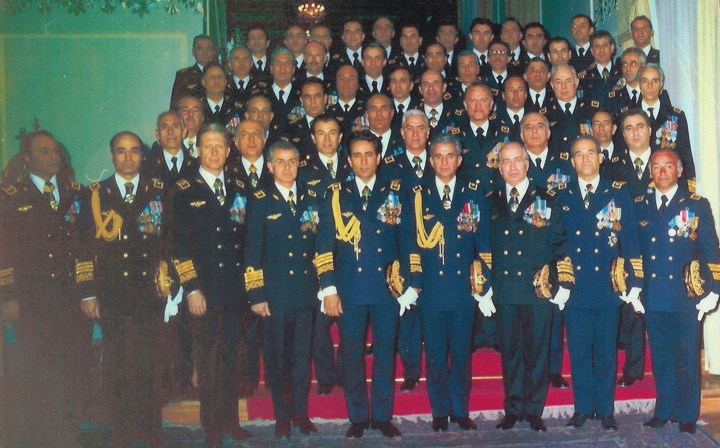
Other Iranian politicians have also questioned the BBC’s revelations, including Ebrahim Yazdi, Khomeini’s spokesman and adviser at the time of the revolution, and Saeed Hajjarian, a reformist figure.
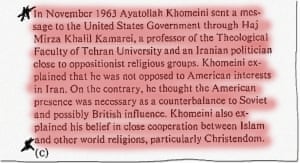
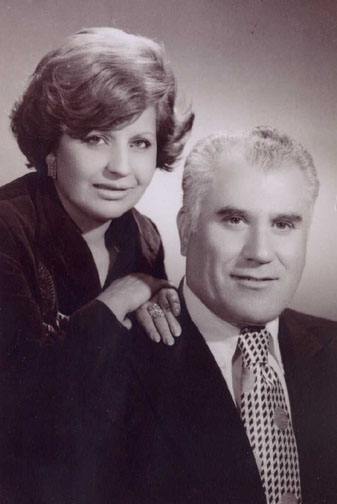 “It is advisable that you recommend to the army not to follow [Shah’s
prime minister Shapour] Bakhtiar,” Khomeini said in one message,
according to the BBC. “You will see we are not in any particular
animosity with the Americans.”
“It is advisable that you recommend to the army not to follow [Shah’s
prime minister Shapour] Bakhtiar,” Khomeini said in one message,
according to the BBC. “You will see we are not in any particular
animosity with the Americans.”.

In another message sent via a US emissary written in the same month, he attempted to assuage American fears that their economic interests would be affected by a change of power in Iran: “There should be no fear about oil. It is not true that we wouldn’t sell to the US.”
.

Khomeini returned to Tehran on 1 February 1979, two weeks after the shah had fled Iran. The Iranian military, which was under US influence, soon surrendered, and within months Khomenei was declared the supreme leader of a new Islamic republic.
Relations with the US were wary from the start, because America was closely identified with the shah’s regime, and links with Washington broke down completely in November 1979 when a group of students stormed the US embassy and took 52 diplomats hostage for 444 days.
.
But despite confrontational rhetoric on both sides, the revolution did not mark an end to direct talks between Iran and the US. The current president, Hassan Rouhani, is believed to have been involved in covert negotiations in which the US agreed to covertly ship arms to Tehran to secure the release of American hostages.
.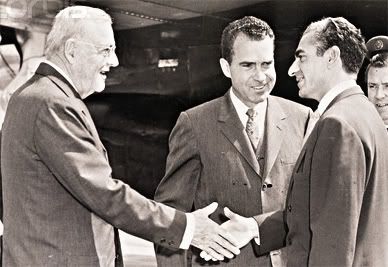
The 1980 CIA study says “in November 1963 Ayatollah Khomeini sent a message to the United States Government through [Tehran University professor] Haj Mirza Khalil Kamarei”, in which he explained “that he was not opposed to American interests in Iran” and that “on the contrary, he thought the American presence was necessary as a counterbalance to Soviet and possibly British influence”. Iranian leaders have vehemently denied that Khomeini ever sent such a message.
.
The Guardian did not have access to the newly declassified documents and was not able to independently verify them. The BBC published the CIA document, but has not published further documents. Most of them appear to be diplomatic cables from Paris and Tehran embassies containing Khomeini’s first-person messages, which the corporation said were in the public domain.
.
BBC Persian has not explained its decision not to publish those documents, which has not helped the skepticism among Iranian critics, but the reporter who broke the story, Kambiz Fattahi, answered questions by email.
“The documents clearly show that Khomeini was less heroic, and far craftier, behind the scenes,” Fattahi said. “He quietly courted the US government, making all kinds of promises about the future of core US interests in Iran.”
.
“The documents are significant because they show Khomeini’s legacy is complicated, as it involves the ayatollah courting two US presidents behind the scenes. They illustrate a pattern of behavior – that Khomeini at critical moments during his long struggle for an Islamic republic, secretly engaged what he would call ‘the Great Satan’.”
.
Gary Sick, a member of the National Security Council staff during the period of the Iranian revolution, said “the documents are genuine” but to the best of his knowledge he never saw the CIA study about the 1963 contact, and had no knowledge of the alleged communication.
.
“As far as I can tell, assuming the report is accurate, the message from Khomeini to the US government had no effect on actual policy – either in the Kennedy administration or later.
.
So I regard this as an anomaly,” he told the Guardian. Sick said the US wanted to preserve the Iranian military as an institution and ensure that the transition would be orderly and not collapse into bloodshed and civil war, but said the talks with an American emissary in 1979 had little significance.
.
“The Khomeini forces were concerned that the Iranian military would launch a coup, which they definitely wanted to avoid at all costs. The US side tried to preserve the threat of a coup as a bargaining lever.”
.
Stuart Eizenstat, a former chief White House domestic policy adviser to Carter, said talks of the US abandoning the shah was “not historically accurate”. He said: “We did everything we could to keep the shah in power. There was no notion that we were trying to facilitate the Ayatollah coming into power.”
.
He also commented: “Ebrahim Yadzi, the first foreign minister under Khomeini, was making regular public statements on behalf of Ayatollah Khomeini saying this will be a tolerant democracy, nothing about an Islamic revolution. I believe that Yadzi believed that.”
.
Mark Toner, deputy spokesperson at the state department, was asked about Khomeini making contact with the Carter administration. “I apologise. I’m not – I’m not aware of that and I don’t have any updates to offer,” he said.
.
The Guardian also approached Zbigniew Brzezinski, who was national security adviser to Carter from 1977 to 1981. He declined an interview on the subject, but said “there were a lot of maneuvers by people at that time and I do not have any special information particularly on the Ayatollah and his role in it. Probably in some fashion there was some involvement but nothing specific that I can recall.”

But despite confrontational rhetoric on both sides, the revolution did not mark an end to direct talks between Iran and the US. The current president, Hassan Rouhani, is believed to have been involved in covert negotiations in which the US agreed to covertly ship arms to Tehran to secure the release of American hostages.
.

The 1980 CIA study says “in November 1963 Ayatollah Khomeini sent a message to the United States Government through [Tehran University professor] Haj Mirza Khalil Kamarei”, in which he explained “that he was not opposed to American interests in Iran” and that “on the contrary, he thought the American presence was necessary as a counterbalance to Soviet and possibly British influence”. Iranian leaders have vehemently denied that Khomeini ever sent such a message.
.
The Guardian did not have access to the newly declassified documents and was not able to independently verify them. The BBC published the CIA document, but has not published further documents. Most of them appear to be diplomatic cables from Paris and Tehran embassies containing Khomeini’s first-person messages, which the corporation said were in the public domain.
.
BBC Persian has not explained its decision not to publish those documents, which has not helped the skepticism among Iranian critics, but the reporter who broke the story, Kambiz Fattahi, answered questions by email.
“The documents clearly show that Khomeini was less heroic, and far craftier, behind the scenes,” Fattahi said. “He quietly courted the US government, making all kinds of promises about the future of core US interests in Iran.”
.
“The documents are significant because they show Khomeini’s legacy is complicated, as it involves the ayatollah courting two US presidents behind the scenes. They illustrate a pattern of behavior – that Khomeini at critical moments during his long struggle for an Islamic republic, secretly engaged what he would call ‘the Great Satan’.”
.
Gary Sick, a member of the National Security Council staff during the period of the Iranian revolution, said “the documents are genuine” but to the best of his knowledge he never saw the CIA study about the 1963 contact, and had no knowledge of the alleged communication.
.
“As far as I can tell, assuming the report is accurate, the message from Khomeini to the US government had no effect on actual policy – either in the Kennedy administration or later.
.
So I regard this as an anomaly,” he told the Guardian. Sick said the US wanted to preserve the Iranian military as an institution and ensure that the transition would be orderly and not collapse into bloodshed and civil war, but said the talks with an American emissary in 1979 had little significance.
.
“The Khomeini forces were concerned that the Iranian military would launch a coup, which they definitely wanted to avoid at all costs. The US side tried to preserve the threat of a coup as a bargaining lever.”
.
Stuart Eizenstat, a former chief White House domestic policy adviser to Carter, said talks of the US abandoning the shah was “not historically accurate”. He said: “We did everything we could to keep the shah in power. There was no notion that we were trying to facilitate the Ayatollah coming into power.”
.
He also commented: “Ebrahim Yadzi, the first foreign minister under Khomeini, was making regular public statements on behalf of Ayatollah Khomeini saying this will be a tolerant democracy, nothing about an Islamic revolution. I believe that Yadzi believed that.”
.
Mark Toner, deputy spokesperson at the state department, was asked about Khomeini making contact with the Carter administration. “I apologise. I’m not – I’m not aware of that and I don’t have any updates to offer,” he said.
.
The Guardian also approached Zbigniew Brzezinski, who was national security adviser to Carter from 1977 to 1981. He declined an interview on the subject, but said “there were a lot of maneuvers by people at that time and I do not have any special information particularly on the Ayatollah and his role in it. Probably in some fashion there was some involvement but nothing specific that I can recall.”